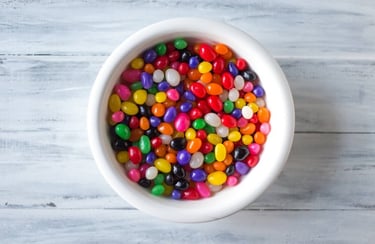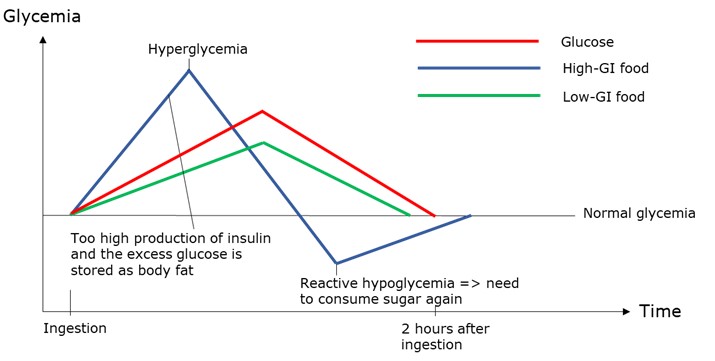The subtleties of glycemic index


The glycemic index is a measure of the speed and intensity with which a carbohydrate food raises blood sugar levels,
i.e., our blood glucose level. It is mainly linked to the composition of fast and slow sugars in the carbohydrate in question, although other parameters are also involved.
The glycemic index (GI) of glucose has been arbitrarily set at 100 for reference, and this number has been made equal to the area found under the curve of the evolution of blood glucose levels during the two hours following ingestion. A high-GI carbohydrate food causes blood glucose levels to rise faster and higher than glucose itself, then fall below normal before rising back to normal. In such a case, the area under the curve is greater than with glucose. If it's 20% larger, the food in question obtains a GI of 120. Conversely, a fast-GI carbohydrate food causes the glucose level to rise more slowly and less steeply than glucose itself, and then fall back to its normal level. The area under the curve is smaller than with glucose. If it is 30% smaller, the food obtains a GI of 70:
This notion of GI is far more relevant than that of energy content expressed in kcal. When a high-GI food is consumed, the insulin produced to rid the blood of excess sugar causes glucose to be stored as body fat. What's more, the rapid drop in blood sugar levels often leads to sweet cravings to combat the resulting drop in energy. Weight gain is thus often encouraged by the consumption of high-GI foods.
There are a few tips for this GI:
Matrix effect: the larger the particle size, the lower the GI. For example, finely ground flour has a higher GI than coarsely ground flour from the same cereal. The juice of an apple has a higher GI than that of the same apple reduced to compote, itself higher than that of the apple still whole. The more you break down the food matrix, the higher the GI.
Complementary effect: if a fast carbohydrate food is accompanied by a slow carbohydrate food, proteins, fatty acids and/or fibers, the fast carbohydrate food will have a lower GI than if eaten on its own. So, for example, when you eat a cookie, it's a good idea to eat a whole piece of fruit at the same time. Fast sugars should always be eaten with other (lower GI) foods.
Gelatinization: whether the result of cooking or of an industrial process, gelatinization increases the GI. For example, pasta cooked al dente (still slightly crunchy) has a lower GI than pasta cooked longer.
Cooling after cooking (retrogradation): this results in a lower GI, as the starch molecules tighten on cooling. For example, cooked and cooled potatoes and pasta have a lower GI than the same cooked potatoes or pasta eaten hot.
Ratio of amylose to amylopectin: the higher the ratio, the lower the GI. For example, basmati rice has a lower GI than white rice, because it contains proportionally more amylose.
Consuming cider vinegar at the same time as a meal lowers the GI of the meal. The more complex the carbohydrates involved, the greater the effect. You can take use two teaspoons of cider vinegar or of lemon juice, as it is the acidity that reduces the speed of starch absorption.
Glycemic load (GL) is an even better way of comparing foods, as it takes portion size into account. GC is the GI multiplied by the number of grams in a portion, divided by 100g.
To find out more, also read these articles:
On the mechanisms involved in weight gain: https://isabellemaesnutrition.com/en/weightgain
On fasting, a practice that can help you reset the way you eat: https://isabellemaesnutrition.com/en/fasting
On the issues of industrial foods compared to a natural diet: https://isabellemaesnutrition.com/en/processed-foods
On how to broaden the range of foods that have a place in a healthy diet: https://isabellemaesnutrition.com/en/forgotten-foods
Candies picture by Patrick Fore


